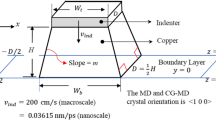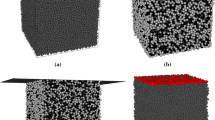Abstract
Much research has been performed for multiscale modeling and simulation of physical phenomena, but it is still a challenging task to effectively describe the evolution of failure across the interface between different spatial scales. Although molecular dynamics (MD) at nanoscale, smoothed molecular dynamics (SMD) at mesoscale and material point method (MPM) at micro- and macro-scales have been combined for multiscale simulations of different problems such as uniaxial tension, bending and plate ones, how to simulate the evolution of shear band across different scales remains to be an open issue. As a result, there is a lack of knowledge in objectively evaluating multiscale failure evolution in general. An effort is therefore made in this work to investigate how the shear banding could evolve between different scales with integrated MD and SMD in a single computational domain, which is verified via a convergence study. The interfacial effect on failure evolution is then explored for the future concurrent MD/SMD/MPM simulations of different physical phenomena under extreme loading conditions.











Similar content being viewed by others
References
He N, Liu Y, Zhang X (2015) An improved smoothed molecular dynamics method by alternating with molecular dynamics. Comput Methods Appl Mech Eng 296:273–294. https://doi.org/10.1016/j.cma.2015.08.005
He N, Liu Y, Zhang X (2016) Molecular dynamics-smoothed molecular dynamics (MD-SMD) adaptive coupling method with seamless transition. Int J Numer Meth Eng 108(3):233–251
He N, Liu Y, Zhang X (2017) Seamless coupling of molecular dynamics and material point method via smoothed molecular dynamics. Int J Numer Meth Eng 112(4):380–400. https://doi.org/10.1002/nme.5543
Chen Z, Jiang S, Gan Y, Liu H, Sewell TD (2014) A particle-based multiscale simulation procedure within the material point method framework. Comput Part Mech 1(2):147–158. https://doi.org/10.1007/s40571-014-0016-5
Jiang S, Chen Z, Sewell TD, Gan Y (2015) Multiscale simulation of the responses of discrete nanostructures to extreme loading conditions based on the material point method. Comput Methods Appl Mech Eng 297:219–238. https://doi.org/10.1016/j.cma.2015.08.009
Liu B, Huang Y, Jiang H, Qu S, Hwang KC (2004) The atomic-scale finite element method. Comput Methods Appl Mech Eng 193(17–20):1849–1864. https://doi.org/10.1016/j.cma.2003.12.037
Su W, Zhang Y, Wu L (2021) Multiscale simulation of molecular gas flows by the general synthetic iterative scheme. Comput Methods Appl Mech Eng, 373. https://doi.org/10.1016/j.cma.2020.113548
Allen MP, Tildesley DJ (2017) Computer simulation of liquids. Oxford University Press, Oxford
Atkins P, De Paula J, Keeler J (2018) Atkins’ physical chemistry. Oxford University Press, Oxford
Frenkel D, Smit B (2001) Understanding molecular simulation: from algorithms to applications, vol 1. Elsevier, Amsterdam
Rowlinson JS, Widom B (2013) Molecular theory of capillarity. Courier Corporation
Tuckerman M (2010) Statistical mechanics: theory and molecular simulation. Oxford University Press, Oxford
Gao Y, Wang F, Zhu T, Zhao J (2010) Investigation on the mechanical behaviors of copper nanowires under torsion. Comput Mater Sci 49(4):826–830. https://doi.org/10.1016/j.commatsci.2010.06.031
Gao Y, Wang H, Zhao J, Sun C, Wang F (2011) Anisotropic and temperature effects on mechanical properties of copper nanowires under tensile loading. Comput Mater Sci 50(10):3032–3037. https://doi.org/10.1016/j.commatsci.2011.05.023
Jiang S, Chen Z, Gan Y, Oloriegbe SY, Sewell TD, Thompson DL (2012) Size effects on the wave propagation and deformation pattern in copper nanobars under symmetric longitudinal impact loading. J Phys D Appl Phys 45(47):475305
Jiang S, Zhang H, Zheng Y, Chen Z (2009) Atomistic study of the mechanical response of copper nanowires under torsion. J Phys D Appl Phys 42(13):135408. https://doi.org/10.1088/0022-3727/42/13/135408
Jiang S, Zhang H, Zheng Y, Chen Z (2010) Loading path effect on the mechanical behaviour and fivefold twinning of copper nanowires. J Phys D Appl Phys 43(33):335402. https://doi.org/10.1088/0022-3727/43/33/335402
Koh SJA, Lee HP, Lu C, Cheng QH (2005) Molecular dynamics simulation of a solid platinum nanowire under uniaxial tensile strain: Temperature and strain-rate effects. Phys Rev B 72(8):085414. https://doi.org/10.1103/PhysRevB.72.085414
Liang W, Zhou M (2004) Response of copper nanowires in dynamic tensile deformation. Proc Inst Mech Eng C J Mech Eng Sci 218(6):599–606. https://doi.org/10.1243/095440604774202231
Wu HA (2004) Molecular dynamics simulation of loading rate and surface effects on the elastic bending behavior of metal nanorod. Comput Mater Sci 31(3–4):287–291. https://doi.org/10.1016/j.commatsci.2004.03.017
Zhan HF, Gu YT (2012) Theoretical and numerical investigation of bending properties of Cu nanowires. Comput Mater Sci 55:73–80. https://doi.org/10.1016/j.commatsci.2011.12.024
Zheng Y, Zhang H, Chen Z, Jiang S (2009) Deformation and stability of copper nanowires under bending. Int J Multiscale Comput Eng 7(3):205–215. https://doi.org/10.1615/IntJMultCompEng.v7.i3.40
Bathe K-J (2006) Finite element procedures. Klaus-Jurgen Bathe, Englewood Cliffs
Bathe KJ, Ramm E, Wilson EL (1975) Finite element formulations for large deformation dynamic analysis. Int J Numer Meth Eng 9(2):353–386
Reddy JN (1993) An introduction to the finite element method. McGraw-Hill, New York
Sulsky D, Chen Z, Schreyer HL (1994) A particle method for history-dependent materials. Comput Methods Appl Mech Eng 118(1–2):179–196. https://doi.org/10.1016/0045-7825(94)90112-0
Chen Z, Brannon RM (2002) An evaluation of the material point method. Sandia National Lab.(SNL-NM), Albuquerque, NM (United States); Sandia National Lab.(SNL-CA), Livermore, CA (United States).
Zhang X, Chen Z, Liu Y (2016) The material point method: a continuum-based particle method for extreme loading cases. Academic Press, Cambridge
Andersen S, Andersen L (2010) Modelling of landslides with the material-point method. Comput Geosci 14(1):137–147. https://doi.org/10.1007/s10596-009-9137-y
Bardenhagen SG, Kober EM (2004) The generalized interpolation material point method. Comput Model Eng Sci 5(6):477–496. https://doi.org/10.3970/cmes.2004.005.477
Charlton TJ, Coombs WM, Augarde CE (2017) iGIMP: an implicit generalised interpolation material point method for large deformations. Comput Struct 190:108–125. https://doi.org/10.1016/j.compstruc.2017.05.004
Nakano A, Bachlechner ME, Kalia RK, Lidorikis E, Vashishta P, Voyiadjis GZ, Campbell TJ, Ogata S, Shimojo F (2001) Multiscale simulation of nanosystems. Comput Sci Eng 3(4):56–66
Su Y-C, Sewell T, Chen Z (2021) Comparative investigation of shear-band evolution using discrete and continuum-based particle methods. Acta Geotech. https://doi.org/10.1007/s11440-021-01150-8
Su Y-C, Jiang S, Gan Y, Chen Z, Lu J-M (2019) Investigation of the mechanical responses of copper nanowires based on molecular dynamics and coarse-grained molecular dynamics. Comput Part Mech 6(2):177–190. https://doi.org/10.1007/s40571-018-0205-8
Raabe D (2014) Recovery and recrystallization: phenomena, physics, models, simulation. Phys Metal, pp 2291–2397.
Galliéro G, Boned C, Baylaucq A (2005) Molecular dynamics study of the Lennard–Jones fluid viscosity: application to real fluids. Ind Eng Chem Res 44(17):6963–6972
Johnson RA (1988) Relationship between defect energies and embedded-atom-method parameters. Phys Rev B Condens Matter 37(11):6121–6125. https://doi.org/10.1103/physrevb.37.6121
Johnson RA (1989) Alloy models with the embedded-atom method. Phys Rev B Condens Matter 39(17):12554–12559. https://doi.org/10.1103/physrevb.39.12554
Mishin Y, Mehl M, Papaconstantopoulos D, Voter A, Kress J (2001) Structural stability and lattice defects in copper: ab initio, tight-binding, and embedded-atom calculations. Phys Rev B 63(22):224106. https://doi.org/10.1103/PhysRevB.63.224106
Chen Z, Han Y, Jiang S, Gan Y, Sewell TD (2012) A multiscale material point method for impact simulation. Theor Appl Mech Lett 2(5). https://doi.org/10.1063/2.1205103
Gu YT, Zhang LC (2006) A concurrent multiscale method based on the meshfree method and molecular dynamics analysis. Multiscale Model Simul 5(4):1128–1155. https://doi.org/10.1137/060654232
Tong Q, Li S (2015) From molecular systems to continuum solids: a multiscale structure and dynamics. J Chem Phys 143(6):064101. https://doi.org/10.1063/1.4927656
Hull D, Bacon DJ (2001) Introduction to dislocations. Butterworth-Heinemann, Oxford
Plimpton S (1995) Fast parallel algorithms for short-range molecular dynamics. J Comput Phys 117(1):1–19. https://doi.org/10.2172/10176421
Thompson AP, Aktulga HM, Berger R, Bolintineanu DS, Brown WM, Crozier PS, in 't Veld PJ, Kohlmeyer A, Moore SG, Nguyen TD, Shan R, Stevens MJ, Tranchida J, Trott C, Plimpton SJ (2022) LAMMPS—a flexible simulation tool for particle-based materials modeling at the atomic, meso, and continuum scales. Comput Phys Commun, 271. https://doi.org/10.1016/j.cpc.2021.108171
Tsuzuki H, Branicio PS, Rino JP (2007) Structural characterization of deformed crystals by analysis of common atomic neighborhood. Comput Phys Commun 177(6):518–523. https://doi.org/10.1016/j.cpc.2007.05.018
Stukowski A (2010) Visualization and analysis of atomistic simulation data with OVITO–the Open Visualization Tool. Model Simulat Mater Sci Eng 18(1):015012. https://doi.org/10.1088/0965-0393/18/1/015012
Chen Z, Schreyer H (1994) On nonlocal damage models for interface problems. Int J Solids Struct 31(9):1241–1261. https://doi.org/10.1016/0020-7683(94)90119-8
Kanel G, Razorenov S, Savinykh A, Rajendran A, Chen Z (2005) A study of the failure wave phenomenon in glasses compressed at different levels. J Appl Phys 98(11):113523. https://doi.org/10.1063/1.2139829
Chen Z (1996) Continuous and discontinuous failure modes. J Eng Mech 122(1):80–82. https://doi.org/10.1061/(ASCE)0733-9399(1996)122:1(80)
Acknowledgements
This work was supported in part by the National Science and Technology Council of Taiwan under the contract number NSTC 110-2222-E-008-009-MY2. Y.C. Su also appreciates the computational time and resources as obtained from National Center for High-Performance Computing, Taiwan.
Author information
Authors and Affiliations
Corresponding author
Ethics declarations
Conflict of interest
On behalf of all authors, the corresponding author states that there is no conflict of interest.
Additional information
Publisher's Note
Springer Nature remains neutral with regard to jurisdictional claims in published maps and institutional affiliations.
Rights and permissions
Springer Nature or its licensor (e.g. a society or other partner) holds exclusive rights to this article under a publishing agreement with the author(s) or other rightsholder(s); author self-archiving of the accepted manuscript version of this article is solely governed by the terms of such publishing agreement and applicable law.
About this article
Cite this article
Su, YC., Chen, Z. Study of the shear-band evolution across the interface between different spatial scales. Comp. Part. Mech. 11, 73–88 (2024). https://doi.org/10.1007/s40571-023-00609-7
Received:
Revised:
Accepted:
Published:
Issue Date:
DOI: https://doi.org/10.1007/s40571-023-00609-7




